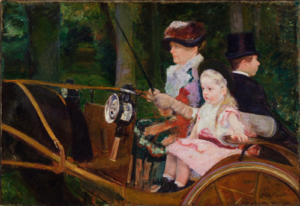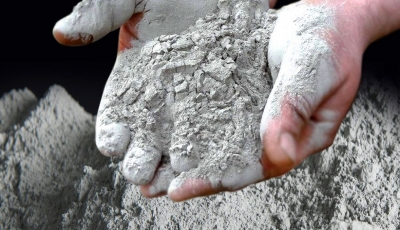Impressionist painters Mary Cassatt and Edgar Degas are considered by many to be two of the best artists active during the late 19th century. However, did you know that the two were also close friends and heavily influenced by one another?
It’s true. The two maintained a strong artistic relationship that spanned decades that inspired many great paintings. As a result, the influence and similarities in style are comparable. Furthermore, although they may have been friends, they were each other’s closest rivals and toughest critics, showing their respect for one another.
They first met in 1877; however, they were open admirers of each other’s artwork years before they met. Before long, the two became loyal colleagues who shared many similar artistic viewpoints, directly influencing the modern art movement.
Table of Contents
ToggleLittle Girl in a Blue Armchair – MARY CASSATT
Little Girl in a Blue Armchair is widely regarded as Mary Cassatt’s best and most famous painting; however, few people know that she had help with it from Degas himself. The two worked together closely to develop Cassatt’s crowning jewel.
By this time, American painter Mary Cassatt was already a successful artist, so it is even more endearing to her character that she was open-minded enough to learn from others such as Degas. Over her career, Cassatt continued to turn to Degas for feedback and direction.
As a result, Degas’s influence can be seen appearing in her work and continuing throughout her collection of beautiful paintings. Lighter colors and a more relaxed brushstroke style developed in Cassatt thanks to Degas, and Little Girl in a Blue Armchair is a perfect example of this.
At the Milliner’s – EDGAR DEGAS
Throughout their friendship, Mary Cassatt occasionally posed as a model in some French artists’ paintings. The 1882 painting titled At the Milliner’s is one such painting that involved Cassatt as the centerpiece of the pastel piece.
Degas regarded himself as more of a Realist painter than an Impressionist, at least during this period, so Degas’s paintings can be seen as a realistic depiction of Cassatt compared to her own more Impressionist-styled self-portraits.
A milliner is a shop that makes, alters, and sells women’s hats. In the painting, Cassatt is trying on hats in front of a mirror while the shop clerk waits with more hats in her hands. Stores like this were quite popular, so this painting also acts as a period piece.
Portrait of Miss Cassatt – EDGAR DEGAS
As mentioned already, Cassatt modeled for many of Degas’s paintings, and many of his most famous paintings involved the American artist, either directly or indirectly. His 1884 portrait titled Portrait of Miss Cassatt is just one of several direct portraits Degas painted of Cassatt.
Also known as Mary Cassatt Seated, Holding Cards as the literal description, it is regarded as one of Degas’s most famous paintings period and certainly his most famous portrait. You can see the comfort in Cassatt’s face and posture, indicating their close relationship as friends.
You can see Degas’s shift from Realism to a more Impressionist style in the painting. However, it is still rooted in Realism, and Degas never fully committed or transitioned to the more modern style. Instead, it mirrored Cassatt’s self-portrait painted around the same time but with a more realistic and detailed finish.
A Woman and a Girl Driving – MARY CASSATT
Mary Cassatt’s 1881 artwork titled Woman and Child Driving is considered one of Mary Cassatt’s famous paintings. By this point, you can also see Edgar’s influence in Mary Cassatt’s artwork and vice versa.
The more this Cassatt painting is studied, the more that is suggested and revealed. In the masterpiece, a woman sits in the front of a horse-drawn carriage while a man sits in the back, being driven by the two. This can be seen as a symbol of Cassatt’s feminist views and beliefs.
Cassatt was a successful and independent woman who was self-sufficient and in the driving seat of her own life. Furthermore, as the two were close at the time, the painting can be interpreted as Degas in the back seat supporting his friend while she takes the reins of her artistic vision; however, this is merely a speculative interpretation.
Mary Cassatt at the Louvre – EDGAR DEGAS
Mary Cassatt at the Louvre is yet another Edgar Degas painting involving his close friend Mary Cassatt as the model. Alongside his portrait of Cassatt, this exquisite painting is considered one of the French artist’s most refined.
This time, however, Cassatt is accompanied by another female figure. Both faces aren’t visible to the viewer as one has its back turned, and the other is hidden behind a magazine. If it weren’t for Degas including Cassatt’s name in the title, it would not be easy to recognize her as the model in this particular painting.
The painting also has a deeper impressionist feel which adds to the mystery of the piece. The painting is part of a collection, including as many as five Mary Cassatt drawings, two paintings, and several pastel works. Much of the collection has been displayed in a public exhibition, while the painting in question currently sits in a private collection.
Conclusion
For American painter Mary Cassatt, a study of her and Edgar Degas’ work reveals some striking similarities and overlapping ideals. But, above everything, Cassatt’s artwork and Degas’s drawings represent something just as important as the paintings themselves; and that something is friendship.
Also Read about: Respite Care: Providing a Break for Family Caregivers











